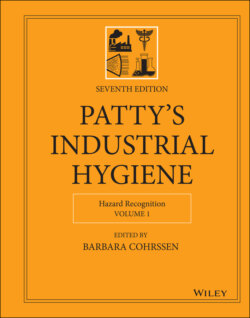Читать книгу Patty's Industrial Hygiene, Hazard Recognition - Группа авторов - Страница 41
6 CONCLUSIONS
ОглавлениеIn the first edition of this book, Frank Patty's vision for the key aspects of successful industrial hygiene practice included: “(i) competent persons in health and safety maintenance departments; (ii) managerial interest and appreciation of the benefits to be derived from health and safety work; and (iii) teamwork, camaraderie, and cooperative efforts among industrial hygiene, medical, and safety personnel” (1). Today, the industrial hygiene profession continues to embrace this vision. While industrial hygiene has traditionally focused on identifying and controlling health risks from a wide variety of workplace stressors, more recently, industrial hygiene professionals have taken on collateral duties in the areas of safety, environmental protection, product stewardship, sustainability, community and public health, and many other areas. This work is concerned with a wide variety of health and safety issues not related merely to “exposures”. Much of this integration has come about either because of regulatory overlap or the need for organizational support staff to be functional across a variety of areas. Further, the diverse training and experience in the field of industrial hygiene can open the door to a very wide variety of other opportunities for a management track or further specialization beyond the traditional exposure assessment focus. Industrial hygienists are especially well suited to an expansion of technical competence and skills given their academic training and problem‐solving approaches to complex technical issues. There are many classically trained prominent industrial hygienists who have become high‐level senior Directors or Vice Presidents in areas such as Sustainability, EHS, Product Stewardship, New Product Development, Government Sponsored Research, and many other diverse areas.
There are a wide variety of new horizons for occupational/industrial hygienists either within or closely aligned with classic occupational/industrial hygiene. While many hygienists retain the classic “exposure and risk assessment” approach, some do not. For example, aligned fields include running an industrial hygiene laboratory, process safety management, managing hazardous waste site remediation (community assessment), and product life cycle assessments (includes much more than exposures such as resource use, impact on the environment, and resource recovery). There are many areas in which the industrial hygienist can contribute to advancing the profession and the health of workers.
So while the profession remains rooted in the basic health and environmental sciences, new challenges utilizing this training and experience continue to develop. As workplaces change with the growth of robotics and other new manufacturing technologies such as digital printers, the hygienist role in health and safety of the workplace and communities will continue to grow and evolve.
